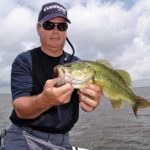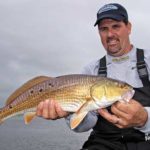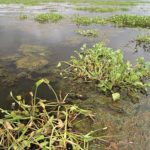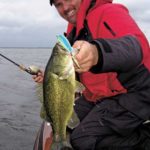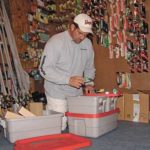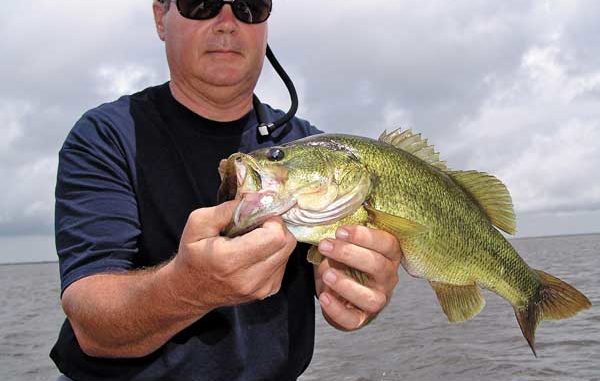
In the aftermath of Gustav and Ike, knowing how to spot tidal bass feeding zones is more important than ever.
A half dozen great egrets and as many blue herons were scattered along the edge of a small cove, and every five minutes or so, they would take a few steps back.
My fishing partner, Sam Swett, a bass tournament pro from Covington, explained our dilemma.
“Those birds are in there looking for the baitfish, and I’ll bet that’s where the bass are,” he said. “The only problem is that the tide is coming in, and that’s too shallow for us to reach.”
A frustrating day in the Delacroix marsh found us battling a gusty wind and restricted by a less-than-favorable tide. Nevertheless, the explosive strikes we saw in and out of our range, plus the dozen or so fish in our boat and as many more in our partnering boat, spoke volumes about the tremendous potential to be found beyond the sweet water.
Here’s the low down: Coastal brine pushes against the edges of inland waterways, encroaching where it can, but otherwise exerting a bully’s shove into rivers, creeks and marshes. Even where saltwater intrusion is not so profound, the daily ebb and flow will swell and contract adjacent waters.
This creates a dynamic environment where water level determines both opportunity and access. Suffice it to say, the feast-or-famine analogy looms large.
Rise and fall
Water level is really the linch pin and the outgoing tide offers the most consistently productive stage. For clarity, a rising tide has plenty of benefit for fish and fishermen.
“When the incoming water floods the shorelines and the shallow ponds, those bass move in to take advantage of all those new food sources,” Swett explained. “If you can reach them, you can catch a lot of fish in these spots.”
No doubt, more water means more depth, and that means you can take your boat into more secluded places. The flipside, however, is that fish will go where fish can go. That means a rising tide usually spreads your quarry across a broad playing field, and you can burn up a lot of daylight searching broad expanses.
However, the old gravitational axiom, “what goes up must come down,” has a definite tidal application. Ultimately, your best tactical advantages ride the falling water. For one thing, declining depths usher bass into tighter confines, where you’re more likely to find good numbers of eager fish.
Capt. Anthony Randazzo of Paradise Plus Guide Service mostly targets redfish and trout, but commonly encounters largemouth bass in his marsh trips. Experience has taught him that the last three hours of an outgoing tide and the first hour of the incoming cycle will find bass hunkered down in their comfort zone, which is generally in deeper sloughs, cuts and main bayous.
“On the higher tide stages, the fish will scatter, and you’re not sure where they’re going to be,” Randazzo said. “But you know on the lower stages that those fish are locked on to those outer fringes.”
Complementing the concentration effect, an outgoing tide typically brings better water quality into an area, and that’s a big turn-on for bass. Swett demonstrated the losing tide’s rejuvenating properties with acuteness in 2004 when he won the FLW Tour event on the Achafalaya Basin.
Fishing main bayous with ditches feeding into ponds lined with abundant vegetation, Swett banked much of his plan on water that would better itself after visiting the interior marshes. Essentially, the rising tide would push characteristically muddy water into the ponds, and the losing tide would draw it out cleaner, thanks to the filtration of grass and weeds.
“When the water comes out, it’s clean, plus it carries out lots of nutrients that baitfish feed on, so of course the bass were there feeding on them,” Swett said. “It was almost like I was fishing a rip line. I was staying on the clean water. Actually as the water fell, the main bayou was cleaning up.”
Finding your Fortune
Translating Swett’s victorious experience into everyday fishing, a few key principles of waning water wisdom emerge for tidal environments. First, finding low-tide bass means finding a pile of aggression. As Randazzo said, bass that settle into low-water spots are rarely lonely.
“If the bass are in a low-water spot, they’re in there with a lot of other competitive fish, so they won’t waste any opportunities (to feed),” Randazzo said. “By ‘competitive fish,’ I don’t just mean other bass — I mean redfish, flounder and maybe even speckled trout.”
Knowing that they have to get while the getting is good, tidal bass tend to feed more fiercely.
“You have a higher percentage of fish that are more aggressive that will give you those impulse strikes, more so than bass in non-tidal environments,” Randazzo said.
When the tide is moving, Swett looks for current-swept points with eddies, fallen trees deposited by hurricanes or any other irregularities that create ambush points. Unlike stillwater bass, which may roam to find baitfish, tidal bass will stake out their feeding spots and pick off what the current delivers.
When in doubt, look for the food line. Wherever the tide concentrates the baitfish, the bass will focus on this feast.
“You have to find where the buffet is,” Swett said. “You’re going to pick off one here, one there, but you’re not going to find the mother lode unless you find the baitfish.”
The mouths of major creeks flowing into a tidal marsh are a good bet for positive influences. Also, pay attention to where the shorebirds gather. They know there’s a limited amount of time to feed on baitfish moving into the nutrient-rich shallows, so a congregation of egrets and herons means food — usually the same type that bass seek. After a good rain, an influx of storm minnows cranks up the action.
Swett described ideal marsh conditions as cloudy or overcast with light-to-medium wind. A soft drizzle can really set off the fireworks, as the surface disturbance combined with low light will mask a fisherman’s presence. Also, rain drops cool marsh waters and invigorate the fish with fresh oxygen.
On the downside, a dead tide, no wind and/or extreme heat are the things that can give marsh bass lockjaw.
Best Baits
Lure choice was important in Swett’s FLW victory. On a chilly February week in which a sharp cold spell had dropped air and water temperatures to lethargic levels, Swett made good use of ¼- and 3/8-ounce Booyah spinnerbaits with Colorado blades.
Had the tournament been a couple of months later, jigs may have been effective at imitating the crawfish and blue crabs that bass often eat in tidal environments. However, with shad the dominant forage, Swett found that running the heavy “thump” of a Colorado blade spinnerbait past the milfoil and hydrilla pulled the bass out of their aquatic heating blankets.
“The Colorado blade forecast that baitfish are coming and that would draw the bass out,” Swett explained.
Other effective baits for tidal bass fishing include Flukes and soft-plastic stick baits on wide-gap worm hooks, topwater plugs, buzz baits and wake baits.
The latter is an extremely shallow-running crankbait that shimmies at or just below the surface, wiggles enticingly and emits fish-enticing rattles. Ideal for zipping down a grass line, a wake bait is also a good choice for working small lanes in marsh vegetation.
One of the most effective baits for marsh fishing is a plastic frog. Rig the soft-plastic bodies Texas style on wide-gap worm hooks with the hook’s bend positioned under the belly as a keel. Leg design varies from kicking paddles to fluttering ribbons, but all simulate an amphibian rushing for cover. Sometimes the frog’s legs will lock together and mar the presentation, so if your frog stops kicking up water, just give it a good tug and you’ll usually straighten out the issue.
For a complete bait right out of the package, try a Spro Frog or the Scum Frog. The former comprises a heavier, denser plastic with a fixed twin-hook design that allows long casts, even in windy conditions. The lighter Scum Frog features a swiveling twin-hook that rotates on the strike for optimal hooksets. Check this bait every few casts, as the free-floating body can become twisted, and that creates snagging concerns.
Wherever you fish and whatever you decide to throw, Randazzo offers advice for tidal scenarios.
“If you’re going to an area and you’re uncomfortable with (its makeup), fish one small area all day, and observe what the tide does through every stage,” he said. “Then base your next day on what you find.”
As Randazzo points out, the lowest tide stage pulls back the marsh’s drapes to reveal bottom contour, obstructions, runouts and other important features.
“At the end of the tide, when all of the really good water has been pulled out of the marsh, you can get a better idea of what’s down there,” he said.
Shooting digital photos, making rough sketches or marking up a chart during low tide will provide invaluable reference once the water returns.
Remember, fishing tidal areas is more about conditions than spots, so learn to spot the right conditions, and you’ll fare well.
